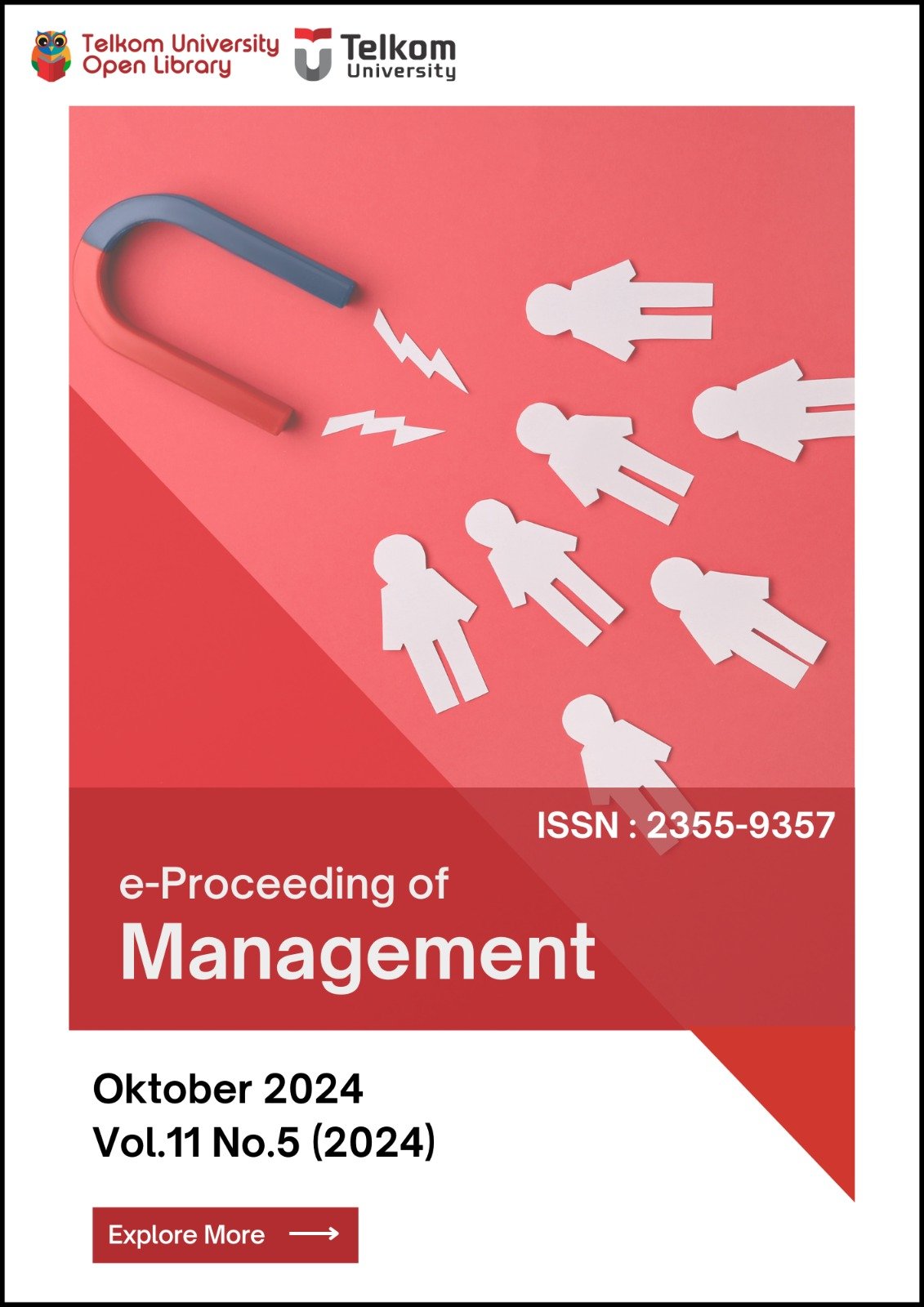Pengaruh Managerial Characteristics, Observability, Relative Advantage, Dan Customer Pressure Terhadap Adopsi E-Commerce Pada Umkm Di Kota Surakarta (Solo)
Abstract
Teknologi Informasiidan Komunikasi (TIK) telah mengubah cara bisnis dijalankan, termasuk UMKM. Dengan
memanfaatkan TIK, UMKM dapat mencapai pasar yang lebih luas dan meningkatkan efisiensi. Salah satu bentuk TIK
yang dapat dimanfaatkan UMKM adalah e-commerce. Adopsi e-commerce oleh UMKM diiIndonesia masih beragam.
Oleh karena itu, perlu dilakukan penelitian untuk mengetahui faktor-faktor yang mempengaruhi adopsi e-commerce
oleh UMKM. Penelitian ini bertujuan untuk mengetahui pengaruh dari Managerial Characteristics , Observability,
Relative Advantage, dan Customer Pressure terhadapiadopsi e-commerce oleh UMKM di Kota Surakarta. Dalam
penelitian ini yang berlokasi di Kota Surakarta. Sampel diambil dengan menggunakan metode non-probability dengan
teknik incidental. Analisis dataidilakukan dengan menggunakan SEM-PLS pada aplikasi Smart-PLS 4. Jumlah
responden di dalam penelitian ini sebanyak 100 responden, data yang dikumpulkan dengan menggunakan kuisioner
yang disebarkan kepada UMKM Kota Surakarta dan dianalisis menggunakan SEM-PLS. Hasil penelitian ini
menunjukkan bahwa variabel Managerial Characteristics memiliki pengaruh negatif terhadap adoption e- commerce
UMKM Kota Surakarta. Namun, pada variabel Observability, Relative Advantage, dan Customer Pressure tidak
memiliki pengaruh positif terhadap adoption e- commerce UMKM Kota Surakarta.
Kata Kunci-customer pressure; e-commerce; managerial characteristic; observability; relative advantage; UMKM.
References
Abdillah, W., & Jogiyanto. (2015). Partial Least Square (Pls): Alternatif Structural Equation Modeling (Sem) Dalam
Penelitian Bisnis (1st Ed.). Yogyakarta: Andi.
Alam, S. S., Ali, M. Y., & Jani, M. F. (2011). An Empirical Study of Factors Affecting Electronic Commerce Adoption
among SMEs in Malaysia. Journal of Business Economics and Management, 12 (2).
Anggadwita, G., Suganda, G. A. D., & Azis, E. (2021). The Implementation of Technology Capabilities, Agile
Leadership and Innovation Ambidexterity to Improve SMEs’ Sustainability in Bandung. Proceedings of the
First Central American and Caribbean International Conference on Industrial Engineering and Operations
Management, 125 – 135. Port-au-Prince. IEOM Society International.
Azadi, A., & Isavand, M. J. (2016). Tax Approach in Iran's E-Commerce. The 4th National Conference on
Management, Economics and Accounting. Tabriz.
BPS Kota Surakarta. (2023). Pertumbuhan Ekonomi Kota Surakarta Tahun 2023.Retriviedfrom
https://surakartakota.bps.go.id/pressrelease/2024/03/04/283/pertumbuhan- ekonomi-kota-surakarta-tahun-2023.html
Busnetty, I., & Tambunan, T. T. (2020). Gap Between Regions in The Use of E- Commerce by MSEs: Macro-Level
Research Using Provincial Data from Indonesia. Journal of Telecommunications and the Digital Economy,
(4), 37- 63.
Candiwan & Wibisono, C. (2021). Analysis of the Influence of Website Quality to Customer’s Loyalty on ECommerce.
International Journal of Electronic Commerce Studies, 12(1), 84 – 103.
Candra, V., Simarmata, N. I., Purba, M. B., Purba, S., Hasibuan, M. C., Romindo, & Jamaludin. (2021). Pengantar
Metodologi Penelitian. Yayasan Kita Menulis.
Chin, W. W. (1998). The Partial Least Squares Approach to Structural Equation Modeling in Modern Methods for
Business Research. Mahwah: Lawrence Erlbaum Associated, 295-336
Chin, W.W., & Newsted, P. R. (1999). Structural Equation Modeling Analysis with Small Sample using Partial Least
Squares in Statistical Strategies for Small Sample Research. Thousand Oaks: Sage Publication
Choi, S.-B., Feng, Y., Liu, J., & Zhu, Q. (2018). Motivating Corporate Social Responsibility Pracices under Customer
Pressure among Small- and Medium- sized Supplier in China: The Role of Dynamic Capabilities. Corporate
Social Responsibility and Environmental Management, 1-14.
Creswell, J. W. (2009). Research Design (Pendekatan Kualitatif, Kuantitatif, dan Mixed). Yogyakarta: Pustaka
Pelajar.
Creswell, J. W., & Creswell, J. D. (2018). Research Design: Qaulitative, Quantitative, and Mixed Methods
Approaches . Amerika: Sage.
Derguti, A., & Shabani, L. (2015). The Impact of Electronic Business on the Development of Small and Medium
Enterprises in the Republic of Kosovo. Europian Journal of Business, Economics and Accountancy, 1-13.
Edo, J. J. R., & Hendayani, R. (2023). The Influence of E-Service Quality on Continuance Intention with Customer
Satisfaction as an Intervening Variable on LinkAja Application Users in Bandung City, International Journal
of Business, Management, and Economics, 4(2), 114 – 131.
Fonseka, K., Jaharadak, A. A., Raman, M., & Tham, J. (2021). Determinants affecting the adoption of E-commerce
and its impact on organisational performance of SMEs in Sri Lanka. Journal of Telecommunications and the
Digital Economy.
Ghobakhloo, M., Aranda, D. A., & Amado, J. B. (2011). Adoption of e-commerce applications in SMESs. Industrial
Management & Data System, 1238-1269.
Ghozali, I. (2021). Partial Least Squares : Konsep, Teknik Dan AplikasiMenggunakan Program Smartpls 3.2.9 Untuk
Penelitian Empiris (3rd Ed.). Semarang: Badan Penerbit Undip
Ghozali, I., & Latan, H. (2015). Partial least squares konsep, teknik dan aplikasi menggunakan program smartpls 3.0
untuk penelitian empiris. Semarang: Badan Penerbit UNDIP.
Hair, J. F. (2021). Business Partial Least Squares Structural Equation Modeling (Pls-Sem) Using R. Jerman: Springer
Hair, J. F., Black, W. C., Babin, B. J., & Anderson, R. E. (2007). Multivariate Data Analysis sevent edition. New
York: McGraw Hill Publishing.
Hair, J. F., Black, W. C., Babin, B. J., & Anderson, R. E. (2019). Multivariate Data Analysis Eighth Edition. Jerman:
Springer.
Hanny, R., Syah, A., & Novita, D. (2020). Analisis Penggunaan E-Commerce terhadap Peningkatan Pendapatan
UMKM Kuliner Kecamatan Sawangan - Depok. Excellent, 56-68.
Hanum, A. N., & Sinarasri, A. (2018). Analisis Faktor-Faktor yang Mempengaruhi Adopsi E-Commerce dan
Pengaruhnya Terhadap Kinerja UMKM (Studi Kasus UMKM di Wilayah Kota Semarang). Media Akuntansi
Universitas Muhammadiyah Semarang, 8(1), 1-15.
He, X., & Bakht, H. (2018). An analysis of administrative management, financial and security barriers in e-commerce
adoption in small to medium size enterprises (SME’s) in the United Kingdom. International Journal of
Computing and Digital Systems, 7(6), 337–346.
Ibnu, S., Mukhadis, A., & Dasna, I. W. (2003). Dasar-dasar Metodologi Penelitian.
Malang: Malang Press
Indrajaya, A. N., Daryanto, W. M., Sjahrifa, C., & Yeung, S. (2019). The Conceptual Model of Spiritual Leadership
and Spirit at Work in Creating a Sustainable Competitive Advantage. International Journal of Business,
Economics and Law, 19(2), 47-51
Indrawati. (2015). Metode Penelitian Manajemen dan Bisnis Konvergensi Teknologi Komunikasi dan Informasi.
Bandung: Refika Aditama.
Jafar-Nejad, A., Sajjadipanah, A., Mirmahale, S., & Ajlighashlajughi, M. (2009). Investigating the Obstacle and
Providing Solution for Using Electronic Commerce in Developing the Export of Iranin Handmade Carpet.
Quarterly Journal of Business, 1-34.
Nuryadi, Astuti, T. D., Utami, E. S., & Budiantara, M. (2017). Dasar-Dasar Statistik Penelitian. Bantul: Sibuku Meida.
Parmono, A., & Zahriyah, A. (2021). Pelaporan Keuangan pada Usaha Mikro Kecil dan Menengah (UMKM) di
Kabupaten Jember. Jurnal Ilmiah Akuntansi Indonesia, 6(2), 209-241.
Pemerintah Kota Surakarta. (2023). Kajian DIgitalisasi IKM & UMKM Kota Surakarta.
Rawash, H. N. (2021). E-commerce Adopting TOE Model by SMEs in Jordan.
Multicultural Education, 118-123.
Rogers, E. M. (1983). Diffusion of Innovations. London: Collier Macmilan.
Sánchez-Torres, J. A., & Juarez-Acosta, F. (2019). Modelling SME e-commerce with IMAES. Journal of Business &
Industrial Marketing, 137-149
Sánchez-Torres, J. A., Berrío, S. P. R., & Rendón, P. A. O. (2021). The adoption of E-commerce in SMEs: The
colombian case. Journal of Telecommunications andtheDigitalEconomy,9(3),110–135.
https://doi.org/10.18080/jtde.v9n3.403
Santoso, T. I., & Indrajaya, D. (2023). Unleashing the Potential: A Comparative Analysis of K-Worker Competencies
among Telkom University Cohorots. Journal of Industrial Engineering & Management Research, 4(4), 39-
Sarstedt, M., Ringle, C. M., & Hair, J. F. (2017). Treating Unobserved Heterogeneity In PLS-SEM: A Multi-Method
Approach In: Latan, H., Noonan,
R. (eds) Partial Least Squares Path Modeling. Springer, Cham. https://doi.org/10.1007/978-3-319-64069-3_9
Schermelleh-Engel, K., Moosbrugger, H., & Muller, H. (2003). Evaluating the Fit of Structural Equation Models:
Tests of Significance and Descriptive Goodness-of-Fit Measures. Methods of Psychological Research Online
(2), 23-74
Sekaran, U., & Bougie, R. (2016). Research Methods for Business. United Kingdom: John Wiley & Sons.
Setiyani, L., Andreansyah, D., Gunawan, R., Yusuf, A. M., & Awalludin, D. (2023). Analysis Adoption e-Commerce
SMEs Using Innovation Diffusion Theory Framework (Case Report: Karawang District). Asia Pacific
Management Research Conference (APMRC 2022), 477-487.
Statista. (2023, Agustus 17). Number of users of e-commerce in Indonesia from 2018to2027.RetrievedfromStatista:
https://www.statista.com/forecasts/251635/e-commerce-users-in-indonesia
Sugiyono. (2013). Metode Penelitian Kuantitatif, Kualitatif, dan R&D. Bandung: Alfabeta.
Sugiyono. (2015). Metode Penelitian Pendidikan (Pendekatan Kuantitatif, Kualitatif, Dan R&D) (Vol. 21). Bandung:
Alfabeta.
Sugiyono. (2019). Metode Penelitian Pendidikan (A. Nuryanto, Ed.; 3rd Ed., Vol.
. Bandung: Alfabeta.
Surakarta.go.id. (2023,). Perkembangan UMKM di Kota Solo dan Dukungan Pemerintah.
Https://Surakarta.Go.Id/?P=29397#:~:Text=Berdasarkan%20pemutakhiran
%20data%20yang%20dilakukan,Yang%20beroperasi%20di%20wilayah%2 0tersebut.
Thong, J., & Yap, C. (1995). CEO Characteristics, Organizational Characteristics and Information Technology
Adoption in Small Business. Omega, 429-442.
Tiandra, N., Hambali, D., Nurasia, & Rosalina, N. (2019). Analisis Pengaruh E- commerce terhadap Peningkatan
Kinerja UMKM (Studi Kasus pada UMKM di Kabupaten Sumbawa). Jurnal Ekonomi dan Bisnis Indonesia
, 6-10.
Toska, A., & Fetai, B. (2023). The Impact of E-commerce on the Economic Growth of the Western Balkan Countries:
A Panel Data Analysis. International Information and Engineering Technology Association, 935-941.
Yadav, R., & Mahara, T. (2018). Preliminary Study of E-commerce Adoption in Indian Handicraft SME: A Case
Study. In: Pant, M., Ray, K., Sharma, T., Rawat. S., & Bandyopadhyay, A. (eds) Soft Computing: Theories
and Applications. Advances in Intelligent Systems and Computing, 584. Singapore: Springer.
https://doi.org/10.1007/978-981-10-5699-4_48
Zahriyah, A., Suprianik, Parmono, A., & Mustofa. (2022). Ekonometrika. Jember: Mandala Press.
Abdillah, W. (2018). Metode Penelitian Terpadu Sistem Informasi.
Yogyakarta: Andi
Ramadhani, F. Y., Astuti, Y., & Indrajaya, D. (2024). Pengaruh Religiosity Serta Theory Of Planned Behavior Pada
Behavioral Intention Dan Dampaknya Terhadap Physical Well Being Pada Pembelian Makanan Halal Di
Aplikasi Oleh Masyarakat Jawa Tengah. EProceedings of Management, 11(2).
Suntara, A. A., Widagdo, P. P., & Kamila, V. Z. (2023). Analisis Penerapan Model Unified Theory Of Acceptance
And Use Of Technology (UTAUT) Terhadap Perilaku Pengguna Sistem Informasi Uang Kuliah Tunggal
Universitas Mulawarman. Kreatif Teknologi Dan Sistem Informasi (KRETISI), 1(1), 1–8.






